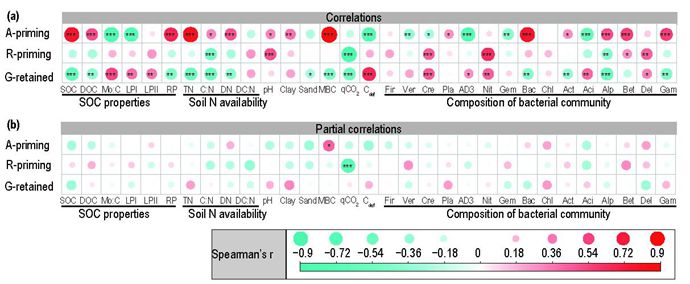Soil contains a large amount of organic carbon (C). Priming and exogenous C incorporation causing by fresh C input are two critical biogeochemical processes that regulate soil organic C content. However, the ecological predictors of soil priming and exogenous C incorporation remain unclear, especially for soils spanning a wide range of climates and soil conditions.
In order to identify the controlling factors on soil priming and exogenous C incorporation, the Global Change Biology Group led by Prof. LIU Feng of Wuhan Botanical Garden presented a study based on 51 soils (belonging to 15 soil profiles in five forest types) along an elevation gradient in the Taibai Mountain. The magnitudes of priming and exogenous C incorporation were determined using a soil incubation of 30 days coupled with 13C-labeled glucose.
Significant elevational and vertical patterns of soil priming and exogenous C incorporation were observed. The priming effect showed hump-shaped trends with elevation, and the proportion of glucose-C retained decreased significantly with elevation. Surface soil had significantly lower priming and exogenous C incorporation than deep soils. The incorporated glucose-C could offset the primed C, and further led to a positive net C balance.
Among the various soil properties (including soil C availability, soil C fractions, soil nitrogen availability, soil C saturation deficit, pH, microbial biomass C, Soil metabolic quotient (qCO2) and soil bacterial composition), relative priming was negatively driven by qCO2 through microbial energy requirement, and exogenous C incorporation was mainly explained by bacterial community composition due to the different life strategies for specific microbial taxa, and qCO2 was a proxy for C utilization efficiency and soil C saturation deficit.
These results emphasized microbial properties played critical roles in regulating soil C cycling under exogenous C input, and the consideration of their effects would improve our understanding in soil organic C dynamic under climate change and the performance of global C models.
Spearman’s correlation (a) and partial correlation (b) matrix between the variables of soil properties and absolute priming, relative priming, the proportion of glucose-C retained (Image by WBG)

Conceptual diagram about microbial properties controlling soil priming and exogenous carbon incorporation, and consequently net carbon balance (Image by WBG)

